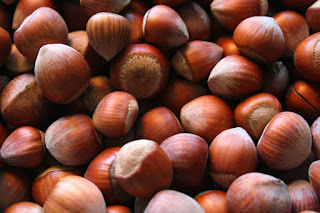The French Revolutionary Calendar celebrates a different tool, plant or foodstuff each day. 8 September is the turn of the Hazelnut. Here are ten things you might not know about hazelnuts.
- Hazelnuts are a member of the Corylus botanical family. The Latin word for hazelnuts is Nux abellana which comes from ‘dried fruit of Avella’, a village in the Avellino province of Italy.
- Hazel comes from the Anglo-Saxon word haesel meaning a headdress or bonnet, referring to the shape of the outer shell.
- Another word for both the nut and the tree is “Filbert”. It's a French word, and thought to derive from St. Philibert, whose feast day (August 22) coincides with the earliest ripening of the nuts in Britain. Yet another word for them is cobnut.
- Hazelnuts are rich in unsaturated fats - the good kind. They're also a good source of magnesium, Vitamins B1, B2, B3, B5, B6, B9 and E. In fact, hazelnuts are the nuts with the second best vitamin E content (Almonds are first).
- In ancient Rome, the Corylus avellana plant symbolised happiness and good fortune, so they were often burned, or given as gifts, at weddings.
- The nuts are oval or spherical and measure about 15–25 mm (0.59–0.98 in) long and 10–15 mm (0.39–0.59 in) in diameter.
- They are harvested in autumn. Growers wait for the nuts to fall from the trees rather than using machinery to shake the trees.
- They go well with Chocolate. The Italians first discovered this in about 1806 when a chocolatier in Turin, Michele Prochet, who was subject to rationing of cocoa products and mixed chocolate with hazelnuts from the Langhe hills south of Turin, to make it go further. He called his creation gianduia and people have been combining hazelnuts and chocolate ever since. The best known chocolate spread, Nutella, is made from hazelnuts.
More Nuts
Browse other topics I've covered in this blog - HERE.
Like my Facebook page for news of Topical Ten posts posts on my writing blog, a weekly writing quote and news of upcoming publications |


No comments:
Post a Comment